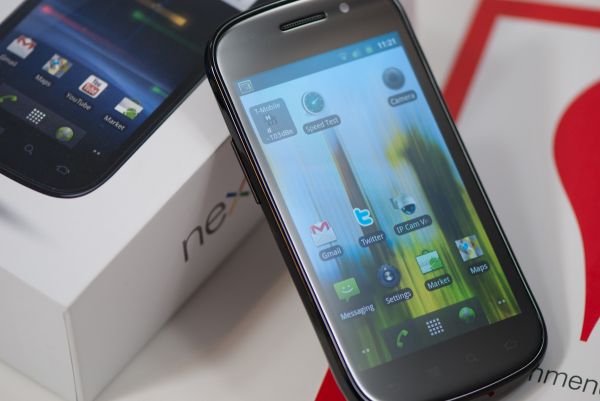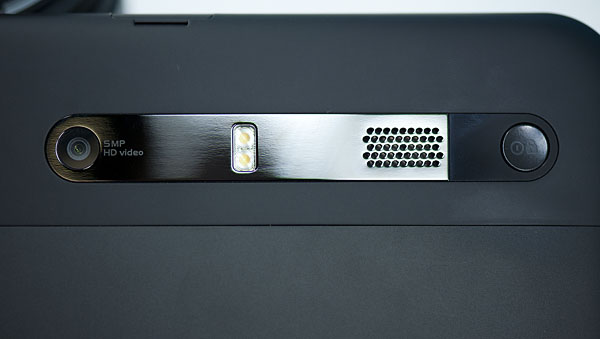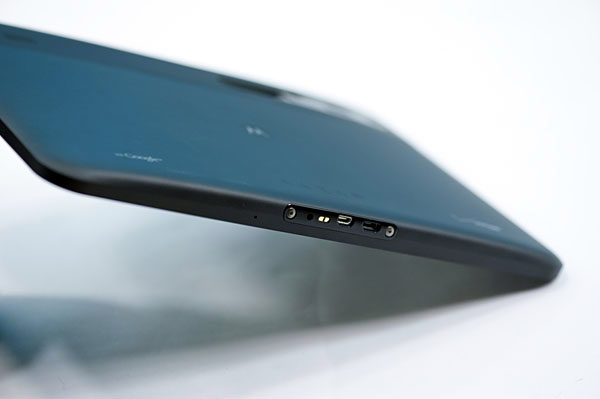Motorola Xoom Review: The First Honeycomb Tablet Arrives
by Anand Lal Shimpi on February 23, 2011 11:57 PM ESTValidation
With the iPad, Apple built a device that I wanted ten years ago, at a time when my workload wouldn’t allow me to use it. I spend most of my days in meetings, producing content, benchmarking and researching. Only the latter is better done on the iPad than a more conventional computing device. The killer apps on the iPad continue to be centered around content consumption and, more recently, gaming. Productivity apps exist, however there are still many usage models that demand the fast response time of a full blown PC or the convenience of a keyboard/mouse, higher resolution display and real working desktop.
That’s just me however. As is evidenced by the number of people I see in airports and airplanes who have traded in their Thinkpads for an iPad, this new era of tablets is serious business. I’m continually amazed by the number of people I see on a regular basis using an iPad, even though I understand why. It’s light, it has a long battery life, it’s easy to use, performance is more predictable than a netbook (thanks to the use of NAND flash vs. a conventional HDD), it’s got a beautiful screen and for some usage models, touching is better than pointing.
A Brief History of Android
Google found itself in an unfortunate predicament in the battle against Apple in the mobile OS space. The iPhone was released in June 2007, but the first Android phone didn’t make it out until October 2008. If Apple were a complacent giant with a stagnant mobile roadmap, showing up 16 months later wouldn’t be an issue. Unfortunately for Google, Apple was anything but that. Execution is critical in any innovation driven industry and Apple has executed extremely well. Since 2007 we’ve seen yearly OS releases (with subreleases in between them) and yearly hardware updates. Since 2007 the hardware updates have come like clockwork, every June we’ve had a new iPhone.
So how do you compete with a company that has a 12 - 24 month head start? Emulation isn’t the answer.
Google would have to out-execute Apple. Similar yearly OS/hardware releases wouldn’t be enough, because Apple would always be ahead at that point. Google wanted to pursue a more open path, with multiple hardware vendors and fully customizable UIs. While that’s great for the consumer, it made Google’s plight that much more difficult.
Apple only had to worry about a single hardware platform that it updated every year. With a dozen or so customers all with varying underlying hardware, Google would have to take longer (or dedicate even more resources) to developing an OS for all of those platforms. Google needed another strategy.
Apple has committed to a 12-month release cadence for OS/hardware, so Google would have to do better than that. On average we get a major Android release every 5 months. Granted Apple does update iOS more frequently than once a year, but Google has definitely come a longer way in the same amount of time thanks to its late start.
A more aggressive release schedule alone isn’t enough. Google wanted to bring Android to more than one hardware manufacturer, but doing so would make out executing Apple nearly impossible. The solution was to pick a hardware and a device partner for each major Android release. Google would work closely with those partners to release the flagship device for that version of Android. All of the other players in the Android ecosystem would be a bit behind the curve. It was a necessary evil in order to rev Android up quickly enough to compete with iOS.

The hardware and device makers were evaluated based on their roadmaps as well as their ability to execute. Last round Samsung was selected as both the SoC and device partner with the Nexus S. Before that it was Qualcomm and HTC with the Nexus One. For Honeycomb, the tablet exclusive release of Android, Google’s SoC partner is newcomer NVIDIA with its Tegra 2. And the device partner? Motorola with the Xoom.
Google and Motorola worked very closely together on the Xoom and as a result, starting tomorrow, the Xoom will be the first Android tablet available running Honeycomb (Android 3.0). Other Honeycomb tablets based on NVIDIA’s Tegra 2 will follow shortly thereafter (Samsung’s Galaxy Tab 10.1, LG’s Optimus Pad) however the Xoom will be first. Down the road we can also expect to see Honeycomb tablets based on other hardware as well.
The Hardware
The Xoom looks and feels like a more rugged iPad. You lose the aluminum finish, but you gain something that feels a lot more grippy and utilitarian. The back is made of the same soft plastic with an almost velvet feel to it that we’ve seen on many smartphones in the past.
The front is all glass of course, however the screen has a much narrower bezel than the iPad making it look a lot more modern. The aspect ratio is also more widescreen than the iPad. The 10.1” screen has a 1280 x 800 display (16:10) vs. the iPad’s 1024 x 768 panel (4:3). As a result the Xoom is the same width in landscape as the iPad, but it’s noticeably shorter (and a little thinner). This gives the Xoom a slightly more manageable feel, although it’s still not as borderline pocketable as a 7-inch tablet.

Motorola Xoom (left) vs. Apple iPad (right)
There are only three physical buttons on the Xoom: volume up, volume down and power/lock. The volume buttons are located along the left edge of the Xoom when held in portrait mode. The power/lock button is actually located on the back of the tablet, near the camera. When held in a landscape orientation the power/lock button should be near the index finger on your left hand. It’s location is actually not that bothersome when you’re holding the Xoom in landscape, it’s when you don’t know how you’re holding the tablet that you run into problems.
The lack of any physical buttons on the face of the Xoom give it a very clean look but also make it very difficult to tell what direction is up when you’re quickly grabbing the tablet. There’s an integrated accelerometer that allows the OS to know how to orient the screen, however when you first pick up the Xoom with the screen off you need to blindly feel around the back for the power/lock button rather than knowing exactly where it is.
Compared to the iPad the accelerometer/rotation magic seems to take longer on the Xoom. The lag between rotating the Xoom and the OS rotating the desktop seems to be just slightly greater on the Xoom compared to the first generation iPad. It’s not a deal breaker, but just a bit odd. Because of the widescreen aspect ratio I found myself using the Xoom in a landscape orientation more than portrait.
There are two cameras on the Xoom: a front facing 2MP and a rear facing 5MP camera with LED flash. The latter is capable of recording up video at up to 720p30. The front facing camera has a red LED next to it that illuminates when the camera is active. Rounding out the light fx are a green charge LED and a white notification LED strip on the front of the Xoom.
There are two speakers on the back of the Xoom, a 1/8” headset jack up top and a micro USB, micro HDMI and power input along the bottom. The micro HDMI port can't be used for mirroring, it looks to be exclusively for getting video out through some of the docks Motorola plans on selling. Update: HDMI mirroring is supported. I couldn't get it working on my Onkyo 508/Samsung UN55C7000 setup however I'll be tinkering around to see why the setup isn't working.
Internally the Xoom has a dual-core NVIDIA Tegra 2 SoC (T20) running at 1GHz. This is the tablet version of the Tegra 2 so it’s a physically larger package but it should have the same performance characteristics. Motorola also includes an Atrix-like 1GB of memory and 32GB of MLC NAND on board. There’s an external facing LTE SIM card tray that also hides the microSD slot in the Xoom.
The Xoom is launching with only one SKU at first: a 32GB 3G (LTE-ready) version priced at $799 through Verizon. This is an unsubsidized cost and it requires a single month of the $20/1GB data plan to function even over WiFi (thank you VZW). The closest Apple competitor is the 32GB iPad 3G priced at $729, a difference of $70. Granted the Xoom does give you two more cameras and two much faster CPU cores than what you get in the iPad, however I’m guessing the more fair comparison will be to the upcoming iPad 2.
| Tablet Specification Comparison | ||||
| Apple iPad | Motorola Xoom | |||
| OS | Apple iOS 4.2.1 | Google Android 3.0 (Honeycomb) | ||
| Dimensions | 242.8mm x 189.7mm x 13.4mm | 249.1mm x 167.8mm x 12.9mm | ||
| Display | 9.7-inch 1024 x 768 | 10.1-inch 1280 x 800 | ||
| Weight |
730g 680g (WiFi only) |
730g | ||
| Processor | 1GHz Apple A4 (Cortex A8) | 1GHz NVIDIA Tegra 2 (2 x Cortex A9) | ||
| Memory | 256MB | 1GB | ||
| Storage | 16GB up to 64GB | 32GB + microSD card | ||
If you want a lower up front cost you can opt for a $599 subsidized version, however that requires a 2-year service agreement at $20. If you’re going to pay for the data plan anyway this may be a better option.
What’s missing of course is a plain old WiFi only Xoom. Motorola says this is coming and will be priced at around $600.














112 Comments
View All Comments
Impulses - Friday, February 25, 2011 - link
Yeah, heh, I use ADW and every single one of my widgets is a scrolling widget (save for the weather widget). This is where I think a lot of people reviewing Android devices miss the mark... They're too focused on the stock software experience, yet one of Android's strengths is how customizable that experience is. You don't have to hack your device or be a geek to install an alternate launcher and a couple of widgets...On my home screen I have a 2x2 SCROLLING widget with my to-do list and immediate appointments, flanked on the right by a 2x2 music player widget w/album art, some shortcuts on the bottom and weather up top. On a different screen I've got a 2x4 SCROLLING widget w/my facebook/email feed (super customizable), elsewhere another 2x4 SCROLLING widget w/a grid calendar, and finally a 3x4 SCROLLING widget w/my news feed.
Those widgets even employ some basic pop-up windows when you interact with them... Hell, they're so well coded they scroll smoother than almost anything else on my phone (though they don't update instantaneously to reflect changes, fast enough tho). Stuff like this is very real and very widely used on Android, but nigh impossible on any other mobile OS, and it's just not taken into account during almost any reviews.
Slap LauncherPro or ADW on many of these phones and half the experience changes dramatically... To review Android devices as if these things don't exist is kind of weird imo.
strikeback03 - Friday, February 25, 2011 - link
While I agree that an article covering some of the customizations available (without rooting) would be useful, I think the bulk of the reviews has to carried out on primarily stock software. A lot of general consumers just want to use the device as is, not be configuring everything.Jinded - Friday, February 25, 2011 - link
This is true to an extent, but if one of the often-quoted advantages of iOS, for example, is the plethora of downloadable apps, then the advantages of Android, such as widgets, especially scrollable and interactive ones, should be pointed out as well.rwei - Thursday, February 24, 2011 - link
Embargoes, not so much3DoubleD - Thursday, February 24, 2011 - link
The third image on the Google Video Chat page says it all... (I like how you squeezed that in there Anand)@ $799, who would buy this?!? The Motorola Execs were smoking some strong stuff to come into the market a year late AND priced above the dominant player, Apple. If everything was perfectly executed on this device and it put the upcoming iPad2 to shame, the price would be justified. This isn't the case though as the lackluster screen, annoying charger, and (current) general instability leaves Apple ample room to upset Motorola's "attempted" market position. Upon release of the iPad2, the Xoom price must fall.
$499 for the Wifi and 3G (with contract) would make more sense. There is simply no room in today's market for a company to compete with Apple on who can sell the highest margin products! On the other hand, perhaps Motorola expects their sales to eat their production capacity whether they are competitive with the iPad2 or not.
Chudilo - Thursday, February 24, 2011 - link
Shame on MOTO for disabling Misro-USB charging. If they wanted to provide a faster charge option, fine. I should still be able to charge it via a standard plug. If it takes 10hrs to charge over microUSB , so be it. It's still better then lugging an extra power adapter around (I just want the option) . If it's an open OS , you've gotta follow through with the hardware. This just made this thing a lot less portable. You can not carry it as a magazine anymore(you can't do it with an iPad either, but again, you shouldn't be trying to match them, you should be trying to beat them).Ideally leaving it plugged in overnight would give it enough juice to run for a decent amount of time. Since this isn't a productivity centered device, it will most likely be plugged in through the night, then be used for a few minuted in the morning to check latest news/weather/music, then be plugged in again for the rest of the day until evening. If you forgot to plug it in then you can always use the fast charger to charge it while you're using it.
I'm going to have wait to see what the docking options will be.
RLMb - Thursday, February 24, 2011 - link
Great review. Very objective and detailed.It's funny how the dynamics of blogs playout. Sites like Engadget, Techcrunch, etc. have their writers write shallow, opinionated, many times with plain false statements. These articles draw hordes of commenters, half calling on the article, the other half defending the article because it "proves" the point they want to make. Other than that they tend to be Apple biased.
I am going to buy the Xoom, the subsidized version with 3G.
I am not a big fan of 2y contracts in general, but I think this one is worth it. The total cost over 2 years is 600 + 480 = 1080 and That gives me 3g access, albeit limited.
If I could buy the same $20/1GB plan for the Ipad, that would cost me $730+480 = 1210 If I used 3g every month. This is $130 more than the Xoom price, so even if I did not use the contract for 6.5 months on the ipad (say vacation, etc.) the Xoom would still be cheaper.
Of course, if you do not plan to use the 3G you should but the Wifi only version.
Impulses - Friday, February 25, 2011 - link
Buying any of these under contract is inane if you're already paying for a smartphone ('cept maybe if you're on AT&T and shackled w/a 2GB data cap)... Just tether them to your phone and use the data connection you're already paying for. If you're gonna be using it for hours on end chances are you're near WiFi anyway (or you can find an outlet to charge your phone and offset the power usage tethering incurs).darckhart - Thursday, February 24, 2011 - link
Pricing on these tablets is all out of wack. I don't argue the functionality and convenience, but the price puts it in the tier of low to mid notebook. How is what amounts to smartphone processing capability, form factor, and touch equal to a notebook? It just isn't. Unfortunately, the ipad set the bar for pricing and people were willing to pay, thus ushering in another sorely mispriced gadget. With the current specs of tablets, they should have debuted in the 250-450$ range.strikeback03 - Thursday, February 24, 2011 - link
Remember, unsubsidized prices on high-end smartphones are generally in the $450-700 range as well. Add a bigger screen and battery and you end up with the unsubsidized prices we are seeing.Devices which try to pack lots of power in smaller spaces have always cost a premium relative to the amount of silicon inside.
That said I think the Xoom would make a lot more sense with a $100-150 price drop in both subsidized and unsubsidized form.